
My generation grew up building models. Marcel poked fun at the art world. This was my way at poking fun at him,"conceptual art", and the model kits of the sixties.
Marcel Duchamp is considered by some as one of the most influential artists of the 20th century. Before you laugh, you have to consider that he was poking fun at the art establishment but, also the first (for better or worst), to experiment with "conceptual art", decades before the term was ever coined.
Marcel's words from a website I found: "In 1913 I had the happy idea to fasten a bicycle wheel to a kitchen stool and watch it turn."

The two sides of the box I made. Having fun with how those old AMT and Revell model kits were sold as Three in One.
He continues, "The Bicycle Wheel is my first Readymade, so much so that at first it wasn't even called a Readymade. It still had little to do with the idea of the Readymade. Rather it had more to do with the idea of chance. In a way, it was simply letting things go by themselves and having a sort of created atmosphere in a studio, an apartment where you live. Probably, to help your ideas come out of your head. To set the wheel turning was very soothing, very comforting, a sort of opening of avenues on other things than material life of every day. I liked the idea of having a bicycle wheel in my studio. I enjoyed looking at it, just as I enjoyed looking at the flames dancing in a fireplace. It was like having a fireplace in my studio, the movement of the wheel reminded me of the movement of flames".

My miniature was based on the one above he made in 1951 for MOMA New York. In many ways it's the the most significant one, since it was the first to be exhibited to the art world. I'm guessing it was the one I saw in my class and art history book.
Duchamp said that the Bicycle Wheel was a "personal experiment", which was never intended to be shown to the public and wasn't formally shown in a gallery space until 1951.

The original Bicycle Wheel (l1913 France), was lost. The one to the left (also lost), was the first recreation made after Duchamp came to the USA in 1916. Many mistakingly refer to the 1916 version as the original since it's the first photographed. No, that's not me (on the right), in my studio. It's Marcel wearing a lampshade with a later recreation of the 1916 version in the sixties.
Since 1951 a few more Bicycle Wheel replicas were made. In Milan 1964, 8 were made based on the 1916 version under Duchamp's supervision and were signed. I came across one that was auctioned off for $1.7 million!

For my wheel, I used the front wheel off a Revell Chopped Hog Harley model. The fork is a cut down top fork tree from the Highway Patrol Harley model with model trees bent as legs. The stool was scratch built from balsa wood, wood dowels, and toothpicks.
Too me, there is something about the juxtaposition of the two objects. I also wonder if I'm the only one that can appreciate this strange combination of models from the sixties and art.
Now, before you shrug his concept off as stupid, think about it. 1. It wasn't Duchamp, rather the art community that made big deal of his Readymades. 2. It was a thinking machine for him to get ideas turning in his head. 3. Who can resist touching and turning a wheel? Who hasn't played with spinning a wheel, or been mesmerized by the criss cross visual flicker of the dance of the spokes?



























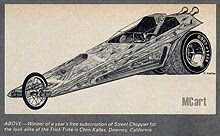









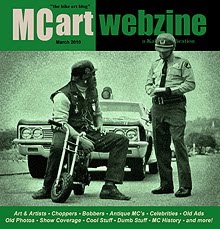


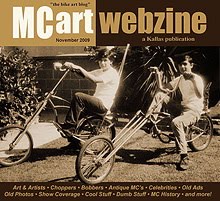






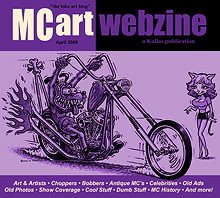

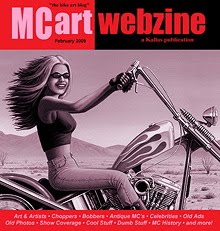
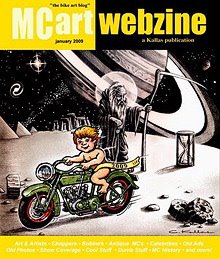




9 comments:
Fucking brilliant...the kit...all of it. Great post.
Cris
Chris,
I love this post. To add, Marcel was part of the Societe Anonyme showings in New York (later Yale) during the 20's and 30's (Which was re-shown at the Hammer recently). Without which I don't think abstract expressionism and then the fifties Kustom car scene would have been able to flourish. His choice to use readymades as you said was revolutionary. Chris, I love your Revell model kit; I think Duchamp would have loved the idea of Revell actually making these as a form of mass production in critique of fine art exclusivity.
Glad somebody likes the post. I was going to add, that I don't remember my instructor or any of my classmates appreciating the humor of my project.
I would also suggest to those interested in more about Duchamp, go to Wikipedia or Google and read up on him.
!!!killer!!!
glad someone sees the overlap of modern art and things that roll. It all connects or relates to other stuff and the chance to see that connection is always good.
I'm def a DuChamp fan! hella punk!
Great post. Tweeted it out to my Art History class.
Nice article, you might be interested in this take on the work
http://www.flickr.com/photos/kingdumb/4713165696/in/photostream
I found your page surfing and you made my day. Thanks. I'd so love to have that box sitting somewhere I could smile at it every day. Well done!
What a clever idea. It's so well thought out! I am delighted to see this.
From the end of the blog post: "3. Who can resist touching and turning a wheel? Who hasn't played with spinning a wheel..."
As a young child, I saw Duchamp's wheel on display at the Phila. Museum of Art.
Impulsively, I gave it a spin. ;)
Post a Comment